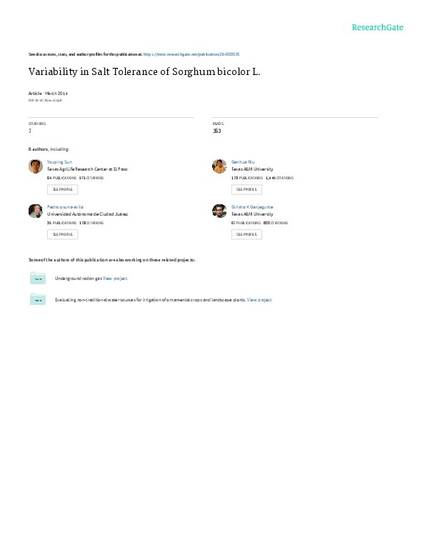
Salt tolerance of ten sorghum (Sorghum bicolor L. Moench) varieties (‘1790E’, ‘BTx642’, ‘Desert Maize’, ‘Macia’, ‘RTx430’, ‘Schrock’, ‘Shallu’, ‘Tx2783’, ‘Tx7078’, and ‘Wheatland’) was evaluated in two greenhouse experiments. In the first experiment, sorghum were sown in substrates moistened with either nutrient solution (no addition of salts, control) at electrical conductivity (EC) of 1.2 dS·m-1 or salt solution at EC 5, 10 or 17 dS·m-1. Seedling emergence percentage decreased in all varieties only at EC of 17 dS·m-1 compared to the control. Seedling emergence percentage of sorghum ‘Macia’ and ‘1790E’ irrigated with salt solution at EC of 17 dS·m-1 decreased by 50% and 51%, while that of ‘RTx430’ reduced by 97%, other varieties ranged from 64% to 90%. Both salt solution at EC of 5 and 10 dS·m-1 reduced the dry weight of sorghum seedlings by 29% and 72% on average, respectively, compared to control. In the 2nd experiment, plants were irrigated with nutrient solution or salt solution at EC of 5.0 or 10.0 dS·m-1 for 30 days. Salt solution at EC of 5.0 and 10.0 dS·m-1 had similar influences on dry weight (DW) of all sorghum varieties except ‘Tx2783’. The relative dry weight of ‘Shallu’, ‘Desert Maize’, and ‘1790E’ irrigated with salt solution at EC of 10 dS·m-1 were over 67%, those of ‘Macia’, ‘Schrock’, and ‘RTx430’ ranged from 30% to 33%, and other varieties were 45% to 59%. Foliar salt damage was observed on all salt-treated sorghum varieties except for ‘Shallu’, which had the lowest shoot DW reduction and greatest visual score. Leaf photosynthesis of all sorghum plants irrigated with salt solution at EC of 5 and 10 dS·m-1 was decreased by 6.0% and 10.6%, respectively. Leaf Na+ concentration at EC of 5.0 and 10.0 dS·m-1 increased by 25.6% and 60.7%, respectively, compared to the control; while Cl- concentration increased by 16.4% and 41.2%, and Ca2+ concentration increased by 17.8% and 34.3%. In conclusion, salt tolerance of sorghum varied with plant growing stage and varieties. ‘Shallu’, ‘Desert Maize’, and ‘1790E’ were the most salt tolerant varieties, while ‘Schrock’ and ‘RTx430’ showed the least salt tolerance in both experiments. All varieties had high Na+ exclusion ability.
